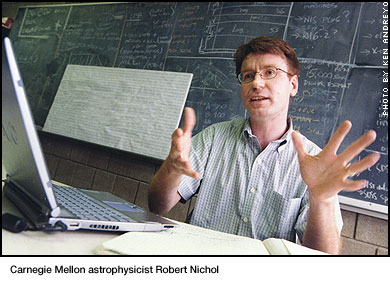|
|
||||
|
|

Work by Astrophysicist Nichol and Colleagues Contributes to Science Magazine's Top-Rated Breakthrough of the Year
Research by Carnegie Mellon astrophysicist Robert Nichol and a team of collaborators at the University of Pittsburgh and the Sloan Digital Sky Survey (SDSS) contributed to a set of important discoveries collectively hailed by Science magazine as the number one scientific breakthrough of 2003, "Illuminating the Dark Universe."
Nichol was part of a team that detected dark energy's "shadow" on the ancient cosmic microwave background radiation, a relic of the cooled radiation from the Big Bang. Dark energy, a major component of the universe and one of the greatest conundrums in science, is repulsive rather than attractive like gravity. This repulsion causes the universe's expansion to accelerate.
The discovery led to an appearance by Nichol on The Late Show with David Letterman this past summer, and media coverage in The New York Times, the New Scientist and other national outlets.
The Pittsburgh-based investigators, working with other astronomers across the country, helped find an imprint of dark energy by correlating millions of galaxies in the SDSS against the cosmic microwave background (CMB) temperature maps from NASA's Wilkinson Microwave Anisotropy Probe (WMAP).
The SDSS is mapping in detail one-quarter of the entire sky, determining the positions and brightness of 100 million celestial objects. It also is measuring the distances to more than a million galaxies and quasars. WMAP is a NASA mission to measure the temperature of the CMB, the remnant heat from the Big Bang. The mission is revealing conditions as they existed in the early universe by measuring the properties of the CMB over the full sky.
Nichol said the work provides a new way of looking at the universe and might help determine the nature of the dark energy. Science magazine said that the SDSS work, in combination with WMAP findings on CMB radiation and data on exploding stars called supernovae "ends a decades-long argument about the nature of the universe."
For more information visit http://www.cmu.edu/cmnews/extra/030725_darkenergy.html
Lauren Ward�
|
||
|
Carnegie Mellon Home |
||||